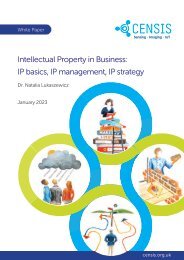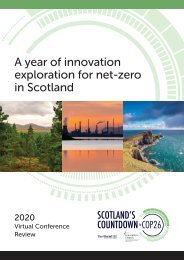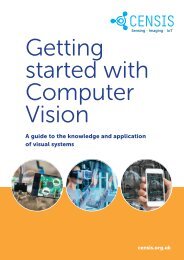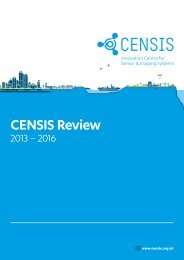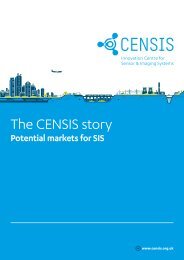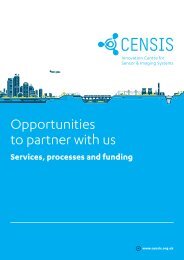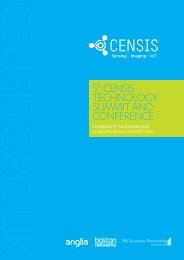Getting started with IoT
IoT is here and it's time for organisations across the country to take advantage of the transformational benefits of the technologies and expertise available. CENSIS explores IoT for business growth in this IoT starter guide. censis.org.uk
IoT is here and it's time for organisations across the country to take advantage of the transformational benefits of the technologies and expertise available. CENSIS explores IoT for business growth in this IoT starter guide. censis.org.uk
You also want an ePaper? Increase the reach of your titles
YUMPU automatically turns print PDFs into web optimized ePapers that Google loves.
Edge computing<br />
Edge computing moves data analysis from the cloud down<br />
to the device itself and allows some or all of the data to be<br />
processed real-time and locally – i.e., at the actual source,<br />
on the device. Edge computing is driven by improvements in<br />
power-efficient processing which enables complex data<br />
processing on small, battery-operated devices. This increased<br />
intelligence at the edge is starting to enable machine<br />
learning and artificial intelligence applications on <strong>IoT</strong><br />
devices. Intelligent edge <strong>IoT</strong> devices will enable many new<br />
opportunities for companies developing <strong>IoT</strong> applications.<br />
Low latency<br />
The round-trip time from<br />
the sender to the receiver<br />
to process is<br />
significantly reduced<br />
Bandwidth<br />
Avoids network<br />
bottlenecks<br />
Closed loop<br />
systems<br />
Onboard processing can adjust<br />
the system in real time to achieve<br />
optimum performance<br />
Benefits<br />
of Edge<br />
processing<br />
Cost<br />
Less data is transmitted<br />
so costs are lower<br />
Privacy<br />
Data is processed at the<br />
device so the application can control<br />
what data to send, potentially<br />
improving privacy<br />
Robust<br />
Offline so more robust<br />
<strong>with</strong>out cloud dependence<br />
3<br />
Communications,<br />
networking and wireless<br />
technologies<br />
Connectivity and networking describe the (often) wireless<br />
technology used to transfer information from the sensors/<br />
end nodes to the cloud. To connect and talk to each other,<br />
all <strong>IoT</strong> devices need connectivity. There is a wide range of<br />
wireless technologies that enable this connectivity, each<br />
<strong>with</strong> their own strengths and weaknesses. Choosing the right<br />
technology will ensure the <strong>IoT</strong> application runs smoothly, at<br />
the lowest cost, and <strong>with</strong> the best power efficiency.<br />
Some wireless technologies existed pre-<strong>IoT</strong>, whereas some<br />
have been designed specifically for it, but all have their own<br />
advantages and disadvantages.<br />
Criteria for wireless technology choice<br />
• Range<br />
• Power consumption<br />
• Data rate<br />
• Module cost<br />
• Connectivity cost<br />
• One/two-way data transfer<br />
• Compatibility<br />
• Global coverage<br />
• Ecosystem requirements<br />
High<br />
Satellite<br />
Range<br />
LoRaWan<br />
Sigfox<br />
LPWAN<br />
NB-<strong>IoT</strong> Cat-M1<br />
Cellular 3/4/5G<br />
RFID<br />
Zigbee<br />
Blue<br />
tooth<br />
Wi-Fi<br />
Low<br />
NFC<br />
Low<br />
Data rate<br />
High<br />
16





